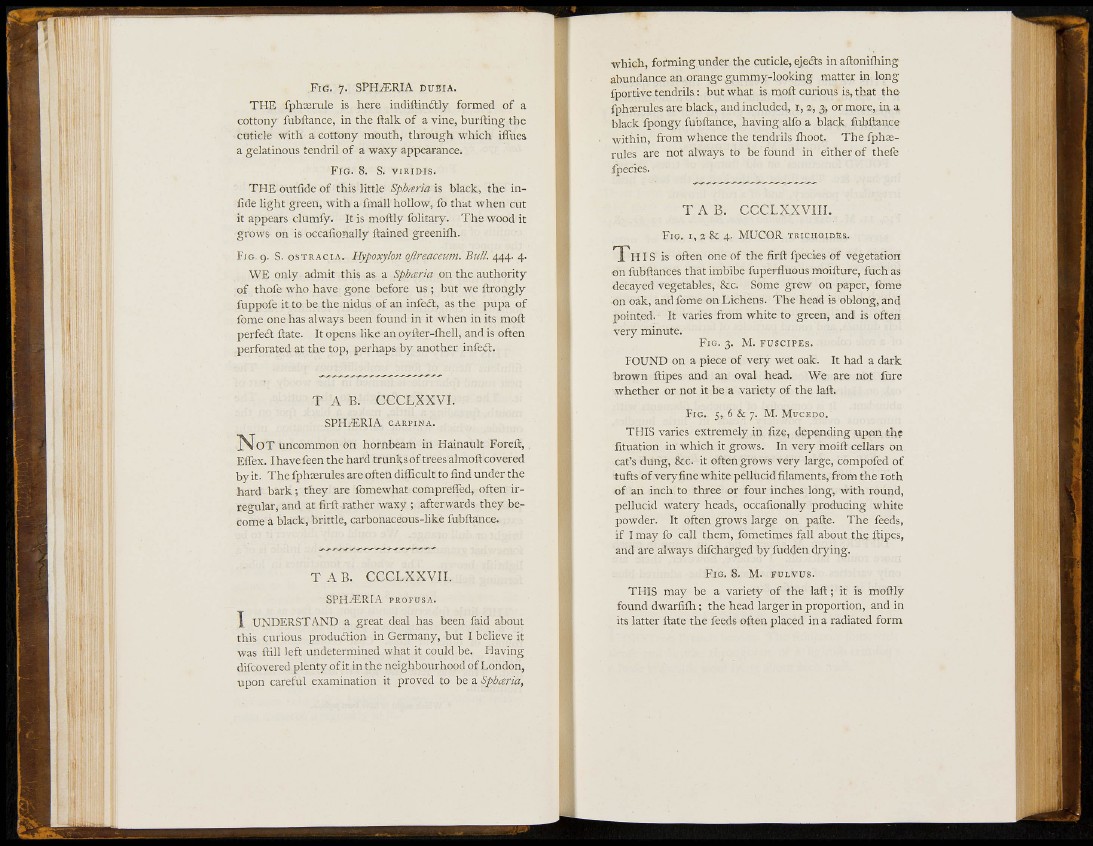
m w
' I
F I G . 7. SPH^RIA DUBIA.
THE fphcemle is here indiftin£lly formed of a
cottony fubftance, in the ftalk of a vine, burfting the
coticle with a cottony mouth, through which iffues
a gelatinous tendril of a waxy appearance.
F I G . 8. S. VIRIDIS.
THE outfide of this little Spharia is black, the infide
light green, with a fmall hollow, fo that when cut
it appears clumfy. It is moftly folitary. The wood it
grows on is occafioaally ftained greenifli.
FJG, g. S. o s T R A C i A . Hypoxylon ojlreaceum. Bull. 444. 4.
WE only admit this as a Sphceria on the authority
of thofe who have gone before us ; but we ftrongly
fuppofe it to be the nidus of an infeft, as the pupa of
fome one has always been found in it when in its moft
perfect ftate. It opens like an oylter-fliell, and is often
perforated at the top, perhaps by another infeit.
T A B. CCCLXXVI.
SPH.Î:RIA CAEPINA.
N O T uncommon on hornbeam in Hainault Foreft,
Effex. I have feen the hard trunks of trees almoft covered
by it. The fphserules are often difficult to find under the
hard bark; they are fomewhat comprefled, often irregular,
and at firft rather waxy ; afterwards they become
a black, brittle, carbonaceous-like fubftance.
T A B. CCCLXXVII.
S P H - « R [ A pRorusA.
I UNDERSTAND a great deal has been faid about
this curious produilion in Germany, but I believe it
was ftill left undetermined what it could be. Having
difcovered plenty of it in the neighbourhood of London,
upon careful examination it proved to be a Spbaria,
which, forming under the cuticle, ejecls in aftonifliing
abundance an orange gummy-looking matter in long
fportive tendrils : but what is moft curious is, that the
fphxrules are black, and included, i, a, 3, or more, in a
black fpongy fubftance, having alfo a black fubftance
within, from whence the tendrils flioot. Thé fphaerules
are not always to be found in either of thefe
fpecies.
T A B . CCCLXXVIII.
Fio. I , a & 4- MUCOR TRICILOIDES,.
T H I S is often one of the firft fpecies of vegetation
on fubftances that imbibe fuperfluous moifture, fuch as
decayed vegetables, &c. Some grew on paper, fome
on oak, and fome on Lichens. The head is oblong, and
pointed. It varies from white to green, and is often
very minute.
F I G . 3. M. FUSCiPEs.
FOUND on a piece of very wet oak. It had a dark
brown ftipes and an oval head. We are not fure
whether or not it be a variety of the laft.
F I G . 5, 6 & 7. M. MUCEDO.
THIS varies extremely in fize, depending upon th?
fituation in which it grows. In very moift cellars on
cat's dung, &c. it often grows very large, compofed of
tufts of very fine white pellucid filaments, from the loth
of an inch to three or four inches long, with round,
pellucid watery heads, occafionally producing white
powder. It often grows large on pafte. The feeds,
if I may fo call them, fometimes fall about the ftipes,
and are always difcharged by fudden drying.